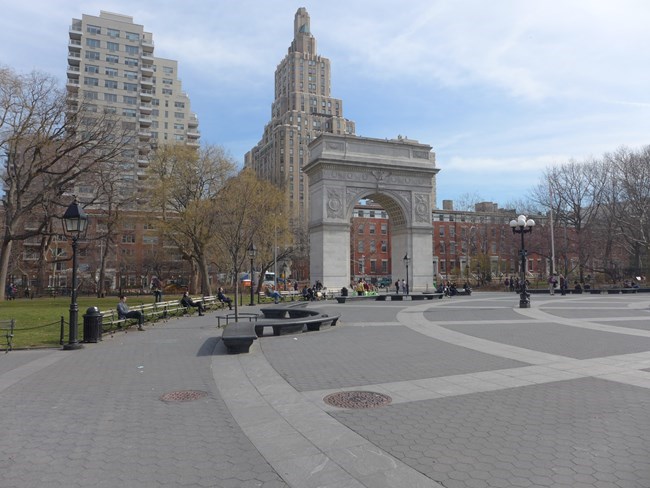Last updated: February 20, 2025
Article
Washington Square: New York City Haven for Bohemians and Activists

NPS Photo/ John Warren
The only thing square is the park
Washington Square in New York City has been known for decades as a place for bohemians, jazz and folk musicians, protesters, poets and people in love. It is also an area where Eleanor Roosevelt rented an apartment from 1942 to 1949.1 So did lesbian author Willa Cather2 and future activist Edith Windsor,3 who won a Supreme Court case against the Defense of Marriage Act.
It was also a place where LGB people could find each other. In 1964, Congressman Ed Koch called for more police in the park to counter "the problem of... homosexuals who have been congregating on Village Square at Eighth Avenue and the Avenue of the Americas."4
On July 24, 1969, a meeting here of “Alternate U,” a leftist “people’s university,” attracted about 40 people interested in gay rights.5 This gay-focused meeting had been scheduled before the Stonewall rebellion less than a month earlier, so timing was fortuitous.6
Six days later, 500 men and women gathered at Washington Square for a Gay Power vigil that marched to the Stonewall Inn. Lesbian activist Martha Shelley was one of those who addressed the crowd. “The time has come for us to walk in the sunshine. We don’t have to ask permission to do it. Here we are!... We’re tired of being harassed and persecuted. If a straight couple can hold hands in Washington Square, why can’t we?”7
On July 31, the second meeting at Alternate U.8 led to the formation of the Gay Liberation Front.9 Even the Front’s name was unapologetically radical, inspired by the National Liberation Front fighting U.S. troops in South Vietnam. This short-lived but important organization focused the energy of the recent rebellion into radical political action rather than the educational approach favored by most “homophile” organizations. The Front soon split, with the more reformist Gay Activist Alliance arising from the ashes. But the important alchemy had already taken place: the raw anger from Stonewall had ripened into a political movement.
Check out the webpage for this inspiring city park to plan your visit, which is still a place for bohemians, musicians, poets and protesters. But, also, please think of the 20,000 people, most of them paupers, buried beneath your feet when this was a potters field between the end of the Revolutionary War and the mid-1820s. It was also the site of the city gallows, where public executions took place.10
Footnotes
1 NYC LGBT Historic Sites Project, "Eleanor Roosevelt Residence," accessed August 20, 2019.
2 Greenwich Village Society for Historic Preservation, "Woman Crush Wednesday: We Love Willa Cather!" Accessed August 20, 2019.
3 Patch, "Edie Windsor Honored With Plaque on Greenwich Village Home," accessed August 20, 2019.
4 Carter, David. Stonewall: The Riots That Sparked the Gay Revolution, St, Martin's Press, 2004, p. 41
5 Carter, pp. 217.
6 Carter, pp. 121-122.
7 Carter, pp. 217-218.
8 NYC LGBT Historic Sites Project, "Gay Liberation Front at Alternate U," accessed August 20, 2019. The building at 530 Sixth Avenue and 69 West 14th Street has since been demolished.
9 Carter, pp. 218-221.
10 Washington Square Park Conservancy, "A Short History of Washington Square Park," accessed August 20, 2019. Also Untapped Cities, "," accessed August 20, 2019.
